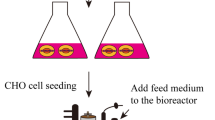Abstract
Effects of high ZnSO4·7H2O supplementation on cell growth and monoclonal antibody (mAb) production in chemically defined suspension cultures of recombinant Chinese hamster ovary (rCHO) DG44 cells were examined. The supplementation of ZnSO4·7H2O up to 120 μM gradually increased specific mAb production rate of rCHO DG44 cells in the early growth phase (0–4 days of culture). The ZnSO4·7H2O concentration for enhancing mAb production without any cytotoxic effects on cell growth was 30–60 μM. In addition of 60 μM ZnSO4·7H2O to in-house protein-free medium and in-house chemically defined medium, mAb production was increased 2.0-fold and 6.5-fold, respectively. Moreover, addition of ZnSO4·7H2O to three kinds of commercial chemically defined media yielded a greater than 1.2-fold enhancement of mAb production. These data indicate that simple supplementation of a relatively high zinc ion concentration to cell culture media without significant changes of rCHO DG44 cell culture process can be useful for achieving high production of mAb.





Similar content being viewed by others
References
Cao H (2004) Expression, purification, and biochemical characterization of the anti-inflammatory tristetraprolin: a zinc-dependent mRNA binding protein affected by posttranslational modifications. Biochemistry 43:13724–13738
Choi YS, Lee DY, Kim IY, Kim HJ, Park HW, Choe TB, Kim IH (2007) Enhancement of erythropoietin production in recombinant Chinese hamster ovary cells by sodium lactate addition. Biotechnol Bioprocess Eng 12:60–72
Cost GJ, Freyvert Y, Vafiadis A, Santiago Y, Miller JC, Reber E, Collingwood TN, Snowden A, Gregory PD (2010) BAK and BAX deletion using zinc-finger nucleaes yields apoptosis-resistant CHO cells. Biotechnol Bioeng 105:330–340
Faure P, Bouvard S, Roucard C, Favier A, Halimi S (2005) Zinc protects HeLa-tat cells against free radical cytotoxicity induced by glucose. J Trace Elem Med Biol 18:269–276
Fukamachi Y, Karasaki Y, Sugiura T, Itoh H, Abe T, Yamamura K, Higashi K (1998) Zinc suppresses apoptosis of U937 cells induced by hydrogen peroxide through an increase of the Bcl-2/Bax ratio. Biochem Biophys Res Commun 246:364–369
Ham RG (1963) An improved nutrient solution for diploid Chinese hamster and human cell lines. Exp Cell Res 29:515–526
Ham RG (1965) Clonal growth of mammalian cells in a chemically defined, synthetic medium. Proc Nat Acad Sci 53:288–293
Hamilton WG, Ham RG (1977) Clonal growth of Chinese hamster cell lines in protein-free media. In Vitro 13:537–547
Hartmann R, Walko G, Justesen J (2001) Inhibition of 2′-5′ oligoadenylate synthetase by divalent metal ions. FEBS Lett 507:54–58
Huang YM, Hu W, Rustandi E, Chang K, Yusuf-Makagiansar H, Ryll T (2010) Maximizing productivity of CHO cell-based fed-batch culture using chemically defined media conditions and typical manufacturing equipment. Biotechnol Prog 26:1400–1410
Kim NS, Lee GM (2000) Overexpression of bcl-2 inhibits sodium butyrate-induced apoptosis in Chinese hamster ovary cells resulting in enhanced humanized antibody production. Biotechnol Bioeng 71:184–193
Lee GM, Hwang SO (2004) Heterologous expression of genes in Chinese hamster ovary cells. In: Baneyx F (ed) Protein expression technologies: current status and future trends. Horizon Bioscience, Norfolk, pp. 427–460
Lee GM, Varma A, Palsson BO (1991) Production of monoclonal antibody using free-suspended and immobilized hybridoma cells: effect of serum. Biotechnol Bioeng 38:821–830
Liu CH, Chu IM, Hwang SM (2001) Enhanced expression of various exogenous genes in recombinant Chinese hamster ovary cells in presence of dimethyl sulfoxide. Biotechnol Lett 23:1641–1645
Mimura Y, Lund J, Church S, Dong S, Li J, Goodall M, Jefferis R (2001) Butyrate increases production of human chimeric IgG in CHO-K1 cells whilst maintaining function and glycoform profile. J Immunol Methods 247:205–216
Morita T, Nagaki T, Fukuda I, Okumura K (1992) Clastogenicity of low pH to various cultured mammalian cells. Mutat Res 268:297–305
Perry DK, Smyth MJ, Stennicke HR, Salvesen GS, Duriez P, Poirier GG, Hannun YA (1997) Zinc is a potent inhibitor of the apoptotic protease, caspase-3: a novel target for zinc in the inhibition of apoptosis. J Bio Chem 272:18530–18533
Urlaub G, Käs E, Carothers AM, Chasin LA (1983) Deletion of the diploid dihydrofolate reductase locus from cultured mammalian cells. Cell 33:405–412
Van DyK DD, Misztal DR, Wilkins MR, Mackintosh JA, Poljak A, Varnai JC, Teber E, Walsh BJ, Gray PP (2003) Identification of cellular changes associated with increased production of human growth hormone in a recombinant Chinese hamster ovary cell line. Proteomics 3:147–156
Wong VVT, Ho KW, Yab MGS (2004) Evaluation of insulin-mimetic trace metals as insulin replacements in mammalian cell cultures. Cytotechnology 45:107–115
Xie L, Wang DIC (1996) High cell density and high monoclonal antibody production through medium design and rational control in a bioreactor. Biotechnol Bioeng 51:725–729
Yoon SK, Ahn YH (2007) Application of sodium propionate to the suspension culture of Chinese hamster ovary cells for enhanced production of follicle-stimulating hormone. Biotechnol Bioprocess Eng 12:497–501
Yoon SK, Ahn YH, Kwon IC, Han K, Song JY (1998) Influence of reducing agents on the secretion rate of recombinant erythropoietin from CHO cells. Biotechnol Lett 20:101–104
Zuqueli R, Prieto C, Etcheverrigaray M, Kratje R (2006) Effect of sodium butyrate and zinc sulphate supplementation on recombinant human IFN-β production by mammalian cell culture. Lat Am Appl Res 36:321–327
Acknowledgments
The authors thank Green Cross Corp. (Kyonggi, Korea) for providing rCHO cell lines.
Author information
Authors and Affiliations
Corresponding author
Ethics declarations
Conflict of interest
The authors declare that they have no competing interests.
Ethical approval
This article does not contain any studies with human participants or animals performed by any of the authors.
Rights and permissions
About this article
Cite this article
Kim, B.G., Park, H.W. High zinc ion supplementation of more than 30 μM can increase monoclonal antibody production in recombinant Chinese hamster ovary DG44 cell culture. Appl Microbiol Biotechnol 100, 2163–2170 (2016). https://doi.org/10.1007/s00253-015-7096-x
Received:
Revised:
Accepted:
Published:
Issue Date:
DOI: https://doi.org/10.1007/s00253-015-7096-x




